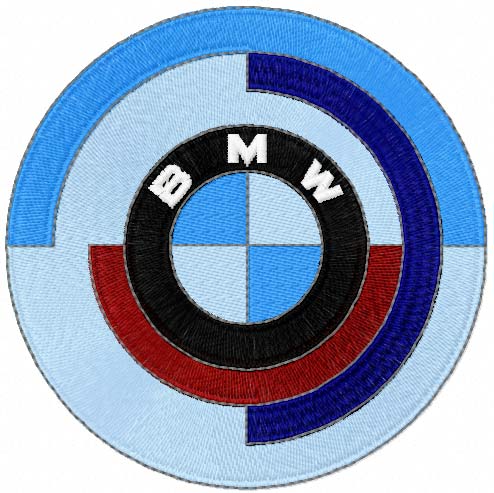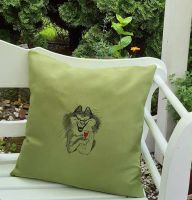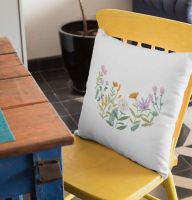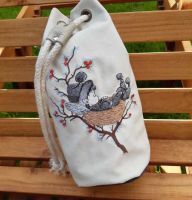BMW embroidery logo for customer
BMW logo machine embroidery design. Format: Janome (jef) Sizes; 3x3, 4x4 , 5x5 inch
Denisov Embroidery Studio offers the latest technology in professional embroidery digitizing service (digitizing- creating embroidery files from art). This is one of our strongest and most talked about digitizing service.

We accept any art format and output any machine embroidery formats; art, dst, exp, hus, jef, pcs, dsb, dsz, xxx, vip, vp3, shv, exp_). We not take money for re sizing and add some embroidery elements. Our staff is very experienced in providing the high quality embroidery digitizing services along with the fastest turnaround time. We work 24 hours every day... Our machine embroidery digitizers have been in the digitizing service for more than fifteen years. We have business partners in Australia, USA, Germany, Norway, Poland, Italy, New Zealand..
We embroider on velvet
Sometimes I find it strange that you can ask such a question: "How to embroider on velvet?", because everything seems to be obvious questions arise. All of this is because I already have some experience in embroidery on velvet and can share simple rules of working with him.
Basic (common) rules of machine embroidery on velvet:
- can not fill in the hoop, as the hoop crush the pile and are still visible traces. You can only use magnets or glue the hoop.
for bonding have options. One can use a special glue stabilizer which is not bonded iron, and has one adhesive side, covered with a protective film such Filmoplast. For example, I do not like to use Filmoplast - it is poorly removed. And if you embroider large designs on it, and then another, and leave it for a while, then in the process of removing it is removed together with fibers of velvet. But keeps the fabric well.
You can use a regular stabilizer that sprinkle glue temporary fix, and then paste it on the fabric. But to use this method for large stitches for designs is at your own risk - Velvet will come unstuck in the embroidery process.
recommendations on the selection of the stabilizer I have met a wide variety. Someone wrote that it is necessary to use a tight cut-off for both chevrons, someone tear the average density. I think that the option of using the cut-off is strange. I use the tear. Or nothing at all put a velvet (if velvet tight and stable and can be hooping).
There is a very common recommendation - fix velvet glued to the stabilizer with an additional line around the perimeter of the design (basting stitch). To me, every velvet endure more punctures and something may remain after cancel hopping. You've got to test.
- must use water-soluble stabilizer on top of velvet to the villi did not show through the stitches. The film must be removed after the embroidery. What is often not so simple. After all, there are designs and fine detail. A wet velvet and you can not do a lot of messing around.
By the way, there are still a few looks at when it is necessary to remove the film from the surface. Who says you have to remove it after embroiderer frame lines, and embroidering final layer of stitches. A majority of advocates for removal after all the embroidery. I think so, because the first method makes to the creation of a program of embroidery only extra unnecessary movements. And do not stop the same car, in the middle of the process of embroidery to tear film.
Alternatively, I met the recommendation to use for the same purpose termoraz damaging stabilizer, for example, Termogas. But to me, this method seems more than doubtful.
- Threads for embroidery can be themselves and diverse in composition of raw materials and thickness.
- Well needles to apply the standard type R or SES. Thickness chosen depending on the thickness of the thread.
velvet are different in composition of raw materials - silk, cotton, viscose, polyester, etc. They are very stable, and there are, knit (stretch), extending in all directions. If velvet sticky glue on the base, and not hooping, it is, in general, it does not matter. But if velvet hooping, its stability is of great importance.
I think that all know that velvet pile fabric. And the pile height is quite different from the very small, almost invisible, until quite decent. I embroidered on velvet, with a height of pile somewhere around 5mm. Such a high-pile velvet is very similar to the artificial fur, but all the same and it's velvet.In
pile height, velvet's still distinguished direction of the pile. In the presence or absence of a particular piece of cloth orientation velvet can be easily seen, having a hand on it in several directions.
What can help or hinder the knowledge of the direction in velvet cloth with machine embroidery? If not using hoop velvet and stick, then nothing. But if it hooping, very even need to know where to look villi.
Yes, yes, I was right when she wrote, "hooping." I, too, once upon a time was surprised such a possibility. However, experience has shown that it is quite possible to do. But use hoop should not hoop, where we can not influence the way and direction of pressure, and in the frame of which are on the industrial embroidery machines. That is, by means of clips. Clips in this case it is necessary to latch in the direction you look nap - in his direction. In this case applied villi minimal damage (if such profiles Tajima-frames.) Well, of course, between clips and velvet must be run extra soft fabric, such as flannel. Traces of clips, of course, remain, but are not as critical as if it used conventional hoop. Also, if you have a good steam and a brush to it, we can fix everything. I'm not arguing for such work needs a lot of experience. But it is still possible.
And last year I bought a cheap velvet, that does not leave marks on the hoop from use - embroider a pleasure. But using hoop for stretch velvet in a frame - sheer torture, not that stick to the paper.
While writing, I remembered another technique of fixing velvet - pinning his pins tucked into the hoop on the water-soluble film. Something else to do. But in the case of a very gentle velvet, too, may well be applied.
Recommendations on the development of a program for the usual velvet special no no, except that:
- Avoid small parts, especially the embroidered stitching simple - because they have to pull out of the film. And, for their size, they will still be sinking in the pile.
- Avoid large area, enveloping the stitches goals - stability in bonding velvet on paper no, the fabric will come unstuck, embroidery deformed. So it is necessary, replace these with something enveloping the more economical type of applications, which, by the way, looks great on velvet.
- framing lines - the most common, corresponding to the size of the element and the stitch length. Oh, and the desired effect, of course. I, however, has repeatedly met the recommendation to put a final layer of satin white stitches at least zigzag, and under the fill - a complete lattice. However, subject to the application of the film on top of pile, work well on velvet and regular programs, without increasing skeletons.
- densities final enveloping the same routine - 0.4-0.45 mm. The main thing is that the fabric is not peep through them.
Comments
Last photos
All photos with our embroidery designs in Gallery
Look at a huge number of beautiful and successful real projects with our work. You can us tags for search.





